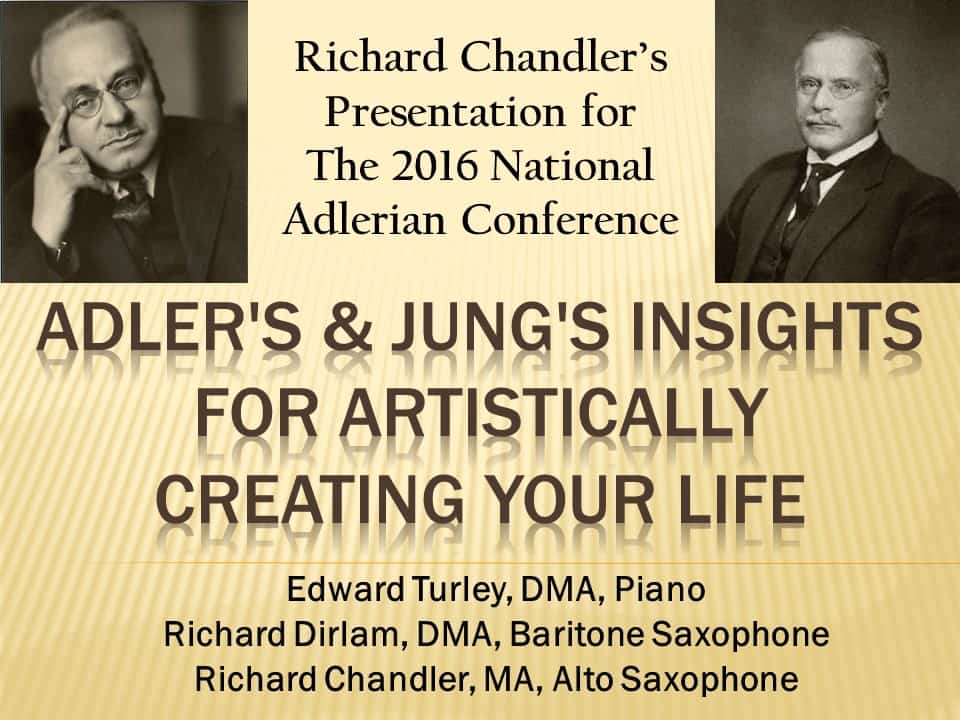
Adler’s & Jung’s Insights for Artistically Creating Your Life
© 2024 Bonnett Chandler, MA, LPCC; Richard Chandler, MA, LPC; Kelly Krueger, MA, LMFT
In May of 2016 I presented Adler's & Jung's Insights for Artistically Creating Your Life to the 64th annual conference of the North American Society of Adlerian
Psychology (NASAP) in Bloomington, MN.
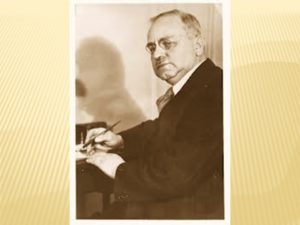
Abstract
This paper applies Alfred Adler’s and Carl Jung’s psychological principles to the question of creating our lives in an intentional and artistic way.
Although there is a body of psychological writings comparing the principles of Alfred Adler to those of Sigmund Freud, and even more writings comparing Carl Jung’s constructs with those of Freud’s writings that compare and contrast Alfred Adler’s body of work to that of Carl Jung’s, are limited. This paper presents affinities, comparisons, contrasts and an integration of Adler’s and Jung’s insights for the purpose of supporting artistic creation and self-actualization.
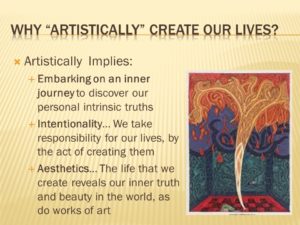
What Motivated this Choice of Topic?
Although much of psychology focuses on dysfunctions in mental health, this writer was curious to discover how people without mental health impairments might utilize the psychological principles of Alfred Adler and Carl Jung to artistically create their lives.
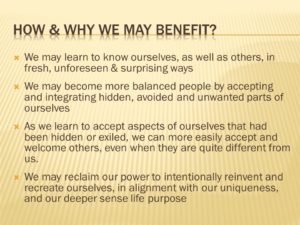
The word “artistically” implies:
- Movement inward, by journeying deeply into our interior psyche.
- Movement outward, by retrieving and transforming our inner discoveries into creations of value, to be shared with others.
- Aesthetics, by creating our lives as works of art, so our individually unique vision of truth and beauty concurrently embraces principles of universality, and therefore connects with our mutual humanity.
- Intentionality, by embracing our responsibility for uniquely creating our lives.
- Action, which is the indispensable ingredient for creating.
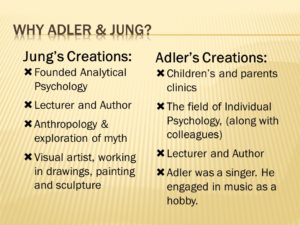
Why Alfred Adler’s and Carl Jung’s Insights Inform Artistic Creation of Our Lives?
In addition to acknowledging the artistic creation shown within their published writings, Adler and Jung personified artistry and creation within their lives. In addition to his life as a psychologist, author, lecturer and the inventor of “Depth Psychology,” Carl Jung lived the life of a visual artist, working in drawing, in painting, and in sculpture mediums (Shamadasani, 2009). Adler also led an artistic life, taking the lead in creating – along with collaboration with his colleagues – the field of “Individual Psychology” (Hoffman, 1994). Along with his associates, he also created a network of children and parents’ clinics in Germany (Hoffman, 1994). Additionally, Adler was a singer and engaged in music as a hobby (Bottome, 1957).
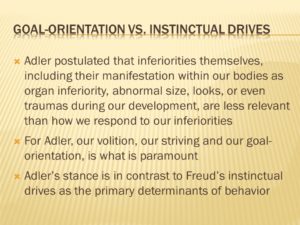
Alfred Adler’s Insights for Artistically Creating Our Lives
Inferiority, Superiority and Assigned Meaning
Alfred Adler (1917) postulated that inferiorities themselves, including their manifestation within our bodies as organ inferiority, abnormal size, looks, or even traumas during our development, are less relevant to living fulfilling lives, than how we respond to our inferiorities (Adler, 1917). For Adler, our volition, our striving and our goal-orientation are paramount. His position sharply contrasted with that of Sigmund Freud, who posited that instinctual drives are the primary motivational determinants of human behavior. Adlerian authors Oberst and Stewart (2003) write:
But in spite of the mutual respect the two men had for each other, a certain rivalry between Freud and Adler existed from the inception of their relationship. It seems that Adler never was wholly convinced of all of Freud’s ideas, especially the concept of sexuality being the primary motivator of most behavior. (Oberst & Stewart. 2003, p. 3)
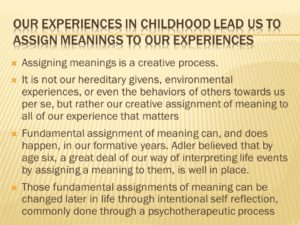
In Alfred Adler’s view (1992), we assign meanings to our experiences, from very early childhood onward. Meanings assignment is a creative process that serves to either empower or disempower us, either connecting us more deeply and empathetically with our fellow humans, or to instead motivate us to cut our ties to others, or even to seek power over them. The meanings that we assign become a filter from which we view all of our new experiences, often reinforcing earlier assignments of meaning. Adler taught that it is not our hereditary givens, environmental experiences, or even the behaviors of others towards us per se, but rather our creative assignment of meaning to all of our experience that matters most (Adler, 1992). He also believed that our foundational assignment of meanings occurs in our formative years. But meaning can be changed later in our lives through an impact of a major life event, or due to intentional self-reflection, commonly occurring within a psychotherapeutic process.
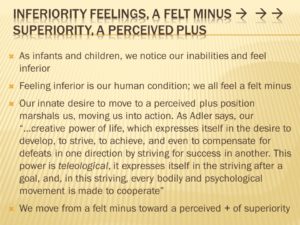
As infants and children, we notice our inabilities and feel inferior to older siblings and adults. Feeling inferior is our human condition; we have all felt, and will continue to feel a “Felt Minus” from time to time. Our innate desire to move to a plus position marshals us. A healthy response is to move forward through actions that give us more of what we want, and away from feelings of inferiority. Alfred Adler writes:
Our …creative power of life, which expresses itself in the desire to develop, to strive, to achieve, and even to compensate for defeats in one direction by striving for success in another. This power is teleological; it expresses itself in the striving after a goal, and, in this striving, every bodily and psychological movement is made to cooperate. (Ansbacher & Ansbacher, 1956, p. 92).
Thus we move from a “Felt Minus” toward a “Perceived Plus” of superiority, which is a healthy human response.
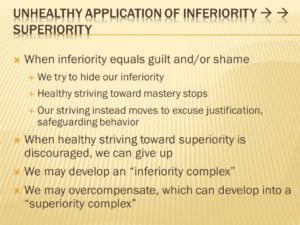
There are three common ways that healthy striving towards superiority might be derailed:
1.When inferiority equals guilt or shame, we might attempt to hide our inferiority. When this occurs, healthy striving toward mastery stops and our striving response instead might become a quest for reasonable excuses as a justification for our perception of inferiority.
2.When healthy striving toward superiority is discouraged, we can give up, which often leads to avoiding situations, or people, that remind us of our inferiorities.
3.We may overcompensate, which can develop into a “Superiority Complex,” as described by Alfred Adler:
The superiority complex, as I have described it, appears usually clearly characterized in the bearing, the character traits, and the opinion of one’s own superhuman gifts and capacities. It can also become visible in the exaggerated demands one makes on oneself and on other persons (Ansbacher & Ansbacher, 1956, p. 261).
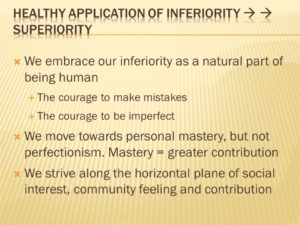
In Adlerian “Individual Psychology” we accept our inferiority as a natural part of being human. In doing so, we embrace two stances that are vital for artistically creating our lives, which Adlerian practitioners are fond of stating. These stances are: “the courage to make mistakes” and “the courage to be imperfect.” Without committing to these stances, our creative striving forfeits to the fear of our own judgments, or the judgments of others, and forfeits to the fear of making mistakes and not arriving at an ideal conclusion in our initial attempts to create. Much of the process of authentic creation involves outwardly creating our inner vision, even though there are no guarantees that our creative work will be met with acceptance. In addition, a great deal of the creative process is one of trial and error as we make multiple attempts to create, followed by the typical realization that we have created something that clearly fails to have a result that we wanted, and a result that others are able to accept as artistically competent.
But in those multiple, imperfect attempts, we learn through our efforts to create something new. We also learn from our creations themselves, as they give us real-world feedback as to what has and has not worked. Through years of attempting, and the feedback that our imperfect creations have provided for us, we move towards personal mastery. It is imperative that we make a critical delineation here, noting that personal mastery is not perfectionism. Moving towards mastery is not done to be better than others, or to achieve perfection; personal mastery is in service to making greater contributions to our fellow humans.
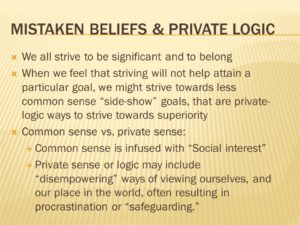
Common Sense vs. Private Sense
Adlerian psychology contends that our deepest need as humans is to belong and to be significant (Oberst & Stewart, 2003). Adler describes our healthy impetus of moving towards superiority, infused with “Social Interest” and “Community Feeling,” which are “Common Sense” ways of contributing. Unlike socially recognized common sense, “Private Sense,” or “Private Logic” along with “Mistaken Beliefs, consists of disempowering ways of viewing ourselves, of viewing others, and of reconciling our place in the world, which might result in procrastination or “Safeguarding” behavior. This can occur should we become discouraged in our striving towards goals in the arenas of work, close relationships or community relationships, placing us instead at risk to strive in less common sense ways, choosing to embrace “side-show” goals, also known as a private logic ways of striving towards superiority (Oberst & Stewart, 2003).
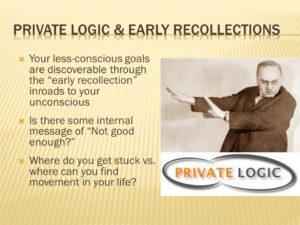
Common sense ways of artistically creating our lives results from examining our own private logic, and mistaken beliefs, so that we may decide whether or not those beliefs are empowering or disempowering. Adlerians do this through a process of recalling our “Early Recollections” or ER’s, in which we recollect memories from the early part of our life. By remembering a specific event or story from our earlier life, we discover a direct pathway into our less-conscious ways of thinking, believing and striving. Examples of disempowering private logic, which may be discoverable through “early recollection” inroads into our unconscious, might include internal messages of not being talented, smart or creative. Through ER’s, we discover insights into our patterns of getting stuck, thus allowing us to make course corrections and restore healthy forward movement towards our common sense goals (H. H. Mosak & R. D. Pietro, 2006).
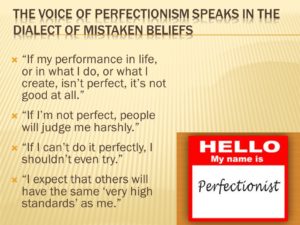
Perfectionism
A private logic mistaken goal, frequently experienced by many, is perfectionism. The voice of perfectionism speaks in the dialect of mistaken beliefs. For both artists who create, and for performance artists, including musicians, dancers and actors, the voice of perfectionism might say:
- “If my stage performance isn’t perfect, it’s not good at all.”
- “If I’m not perfect, people will judge me harshly.”
- “If I can’t do it perfectly, I shouldn’t even try.”
- “I expect that others will have the same standards as me.”
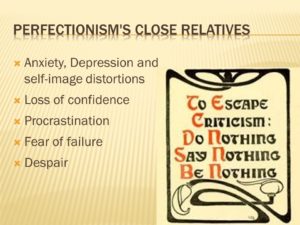
Perfectionistic ways of believing has disempowering relatives. They include:
- Anxiety, depression and self-image distortions
- Loss of confidence
- Procrastination
- Fear of failure
- Unwillingness to risk
- Despair
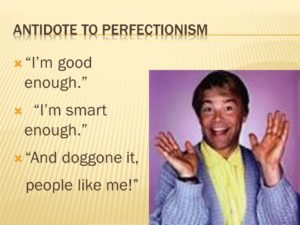
Perfectionism’s Antidotes of Adopting Realistic Standards and Horizontal Striving
One antidote to perfectionism is to externalize it. This author suggests calling it: “The voice of perfectionism, who speaks in the dialect of mistaken beliefs.” This voice tries to convince us that we should not even try to artistically create our lives, as we don’t have what it takes to do it perfectly. This statement is an example of a mistaken belief, because we know that even if we do not achieve some unattainable perfection, we still will create our lives in more optimal ways than would be the case if we had heeded this voice and not even tried. Adlerians like to tell themselves and others that they will just “take a whack at it.” When concerned over whether or not their creation, or their performance, was stellar in every way, Adlerians tell themselves that it was “good enough.” We would do well to recall humorist and politician Al Franken’s fictitious character, Stuart Smalley, who self-soothed by saying: “I’m good enough. I’m smart enough. And doggone it, people like me” (Franken, 1991)
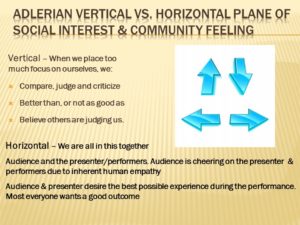
An Adlerian construct that is particularly helpful for performance artists, as well as anyone who feels exposed when in front of others, is the “Vertical Plane of Striving vs. the Horizontal Plane of Social Interest and Community Feeling.” When people strive vertically, it is as if they live their lives on a skyscraper’s elevator, and are constantly monitoring who is living a higher floor and who they have risen above. When their performance goes well, it is if as if they have ascended several floors and can look down on even more people; but when their performance isn’t as good, their elevator descends to a lower floor of diminished status. Vertical striving places too much focus on us. We might compensate by:
- Comparing, judging and criticizing
- Occupying ourselves by deciding who we are better than, or not as good as
- Believing that others are judging us, because after all, we are judging ourselves
Horizontal striving, in contrast, confirms that we are all in this together, audience and presenter or performers alike. We believe that the audience is cheering on the presenter or performers, due to inherent human empathy. Because the audience, presenter or performer, and even behind-the-scenes stage people, all are co-creators of an event, everyone present desires the best possible experience and outcome for the performance. Therefore, if we are in the role of performer or presenter, we can afford to relax and let go; positive support is ever present.
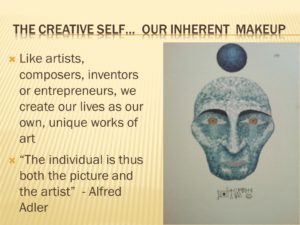
The Creative Self
The final Adlerian concept that informs how we may artistically create our lives is “The Creative Self.” Alfred Adler believed that our inherent makeup, in terms of the ways in which we create our lives, is artistic. In other words, like artists, composers, inventors or entrepreneurs, we create our lives as our own, unique works of art. It is our creative volition that determines what we strive for in life. Adler (1956) said: “The individual is thus both the picture and the artist” (p. 177).
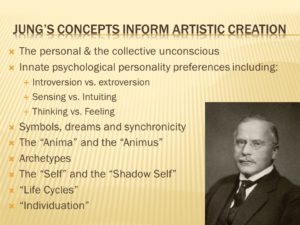
Carl Jung’s Concepts Inform Artistic Creation
The Personal and the Collective Unconscious
The “Personal Unconscious” informs us on what may have gone unnoticed in our lives. It our personal repository for original ideas, felt emotions, images, soundscapes and improvisational kinesthetic impulses. All of these, and many more, are our foundational building blocks, the source material for what we create. What truly wants to come through for uniquely creating our own way, which Jungian Galen Martini (2006) describe as the process of “Individuation,” arises from our personal unconscious via our dreams, the symbols that we are attracted to, or even through synchronous events that we both notice and mine as a source of artistic insight (Martini, 2006).
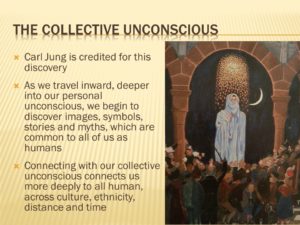
The discovery of the “Collective Unconscious” is primarily credited to Carl Jung (Shamadasani, 2009). As we travel inward, into the deepest regions of our personal unconscious, we leave our personal references behind and have traveled into a vast repository of images, symbols, stories and myths that are common to all of us as humans. The collective unconscious connects us with all of humanity, across culture, ethnicity, geographic distance and even time.
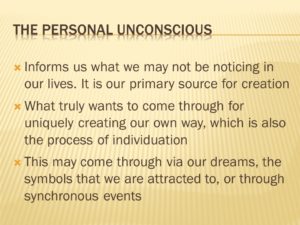
In illuminating Carl Jung’s understanding of the relationship between the personal and collective unconscious, author Sonu Shamadasani (2009) writes:
[Jung] … differentiated two layers of the unconscious. The first, the personal unconscious, consisted in elements acquired during one’s lifetime, together with elements that could equally well be conscious. The second was the impersonal unconscious or collective psyche. While consciousness and the personal unconscious were developed and acquired in the course of one’s lifetime, the collective psyche was inherited. … [Jung] discussed the curious phenomena that resulted from assimilating the unconscious. He noted that when an individual annexed the contents of the collective psyche and regarded them as personal attributes, they experienced extreme states of superiority and inferiority. He borrowed the term godliness from Goethe and Alfred Adler to characterize the state, which arose from fusing the personal and collective psyche, and was one of the dangers of analysis. (S. Shamadasani, 2009, p. 208)
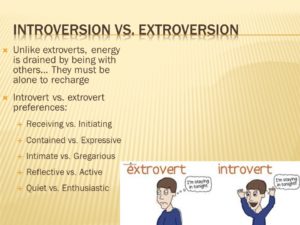
Psychological Personality Types
Carl Jung was the first to write about our innate psychological personality preferences, or psychological types (Jung, 1971). The overall polarities that he established include:
- Introversion vs. extroversion
- Sensing vs. intuiting
- Thinking vs. feeling
- Perceiving vs. judging, or decision-making
All of these polarities may be measured by taking the Myers-Briggs® assessments, which are based in large part upon Jung’s constructs. It is this writer’s belief that people may gain advantageous insights into themselves and others, by taking and receiving an interpretation from an experienced Myers-Briggs practitioner of the MBTI® Step II psychometric instrument, which subdivides each of the above polarities into five sub-processes (K. D. Myers & P. B. Meyers, 2001, 2003). Although the simplistic Myers-Briggs instrument is helpful, the additional precision and clarity gained through the MBTI® Step II instrument and interpretation is superior for understanding how to artistically create the life that we aspire to.
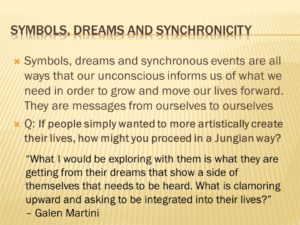
Symbols, Dreams and Synchronicity
The landscape of our personal and collective unconsciousness is largely made up of symbols, dreams and the common experience of synchronicity. Paying attention to the symbols that we are drawn to, or repelled by, in our waking life, as well as the symbolic meaning of our dreams, illuminates the meaning we assign to our lives. This rich reservoir from our unconscious informs us of what we need to consider in order to grow and to move our lives forward. Our unconscious symbols, dreams and synchronous events are messages from ourselves, to ourselves (Martini, 2011).
The “Anima” and the “Animus”
Like Alfred Adler, who talked about the role of gender guiding-lines as an aspect of our “Style of Life,” Carl Jung wrote about the influence of masculine and feminine energies within the totality of our self, which he identified as the “Anima” and the “Animus.” Artistically creating our lives may be informed by considering the ways in which “Yin” or female energies, and “Yang,” or male energies, consciously and unconsciously influence us. Artistic creation may be enhanced by choosing to include more yin energy, so our creations may be fluid and flowing. In contrast we might find greater benefit by incorporating more yang energy, instead emphasizing structure and more defined boundaries, in order to achieve the life that we want. Men may particularly find balance by consciously embracing the female energy of the anima, while women often achieve greater balance by embracing their inner animus, their masculine energy (Millner, 2004).
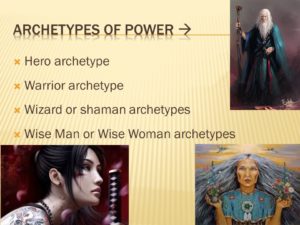
Archetypes
Through insights gained from his lifelong interest in stories, fairytales, myths and the metaphysical beliefs of other cultures, as well as from his own personal journey into the collective unconscious, Carl Jung wrote about archetypal life patterns (Jung, 1964). Those that most directly apply to artistically creating our lives revolve around archetypes of personal power, wisdom and the act of creating itself. Creation-oriented archetypes include:
- The “Hero”
- The “Warrior”
- The “Wizard” or “Sorcerer”
- The “Shaman”
- The “Wise Man” or “Wise Woman”
- The “Artist”
- The “Muse”
- The “Musician”
For most people, archetypes operate unconsciously, emanating as they do from the realm of the collective unconscious. By bringing our archetypal influences into conscious awareness, we have the opportunity to examine the extent to which they empower or disempower us. In many ways, artistic archetypes have chosen us. By acknowledging those patterns that do hold sway over our lives, and consciously choosing the archetypes that best support our aspirations, we may enlist our mix of archetypes as allies in our quest to artistically create our lives.
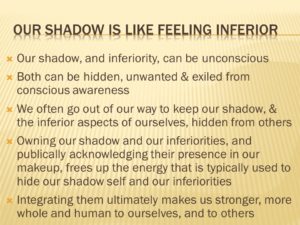
The “Self” and the “Shadow Self”
In Carl Jung’s mapping out of the psyche, we find both the conscious and unconscious construct of the “Self,” which, in part, includes:
- Our persona, which is the aspect of our identity that we are comfortable sharing with others
- Our ego consciousness, the aspect that we relate to as our conscious inner “I”
- Our shadow self, which operates both within our conscious awareness and below it, in the realm of our personal unconscious (Millner, 2004).
Our shadow self contains thoughts, feelings, desires and biases that may be embarrassing, shameful or even abhorrent to us, and also perhaps to others. It may also contain latent aptitudes and artistic sensibilities that yet remain unexplored (Jung, 1964).
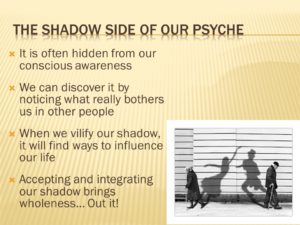
Jungian’s believe that when our shadow self remains hidden from our conscious awareness, it can powerfully influence our thoughts and behavior in ways that undermine ego-control of our lives and lead to destructive ways of thinking and behaving. Confronted by our shadow, we commonly respond by ignoring it, denying it, or distancing ourselves from uncomfortable or even painful awareness of our shadow self.
To more successfully create our lives in an artistic way we need to do the opposite; we must welcome and except those unwanted aspects of our “Self” into conscious awareness. Paradoxically, by doing so, those previously exiled shadow aspects of our “Self” may be reincorporated into the totality of our conscious awareness, and therefore those shadow aspects’ capacity to negatively impact our lives is to a large extent mitigated, for they no longer operate as a shadow government, controlling the operations of our lives without the conscious permission of our ego (personal communication, August, 2014). For those latent shadow aspects, rich with artistic potential, the act of welcoming and embracing our shadow might prove to be fruitful and rewarding as we artistically create our lives.

How might we explore our shadow selves? For the more troubling aspects of our shadow, Jungian’s have recommended that we begin by noticing what really bothers us in other people, paying special attention to those words, beliefs or actions of others that precede a strong emotional reaction from us, as this is a major clue that we too house similar thoughts, beliefs or propensities within our own psyches.
Our dreams may also inform us of those latent, unexplored parts of ourselves. While interviewing Jungian Analyst Galen Martini, I asked: “If people simply wanted to more artistically create their lives, how might you proceed in a Jungian way?” She responded: “What I would be exploring with them is what they are getting from their dreams that show a side of themselves that needs to be heard. What is clamoring upward and asking to be integrated into their lives” (G. Martini, personal communication, August 28, 2014). This is the key to working with our shadow selves; reintegration of our shadow into conscious awareness brings wholeness to our lives, allowing us to transcend and overcome the paralysis of a fragmented self. Instead of vilifying our shadow, we out it!
Life Cycles
Carl Jung addressed the cyclic nature of our lives, from the early acquisition of knowledge and experience, to our rising competence in our 20s and 30s, to the disruptive falling apart that so often occurs in midlife and through a reintegration towards a more holistic expression that may best describe our later years. Artistic creation frequently requires that something die in order for something new to be born (Millner, 2004).
As people have the courage to allow many aspects of their earlier adult life to die, there seems to be a kind of rebirth that occurs, a re-animation of their life by a self that had been largely ignored, a self that might remind a person more of how they were in their teenage years, in terms of being more optimistic and confident about life’s possibilities, their possibilities. (Chandler, 2013, p. 4)
Individuation
Jungians believe that all healthy people go through a process of individuation; we grow by breaking away from the life prescriptions written for us by our families of origin. To artistically create our lives, or to actually become an artist, an even greater degree of individuation often occurs as an expression of finding one’s own way, both in living life and through acts of creating. Galen Martini (2006) states:
By tapping your unconscious strengths and uncovering repetitious, negative or self-defeating patterns you can find and reclaim your life. … With reflection, you can move out of old worn out attitudes, “the old house” of self-sabotaging beliefs that you designed and inhabited to protect yourself at an earlier time, and into the house of yourself.” (Galen Martini, 2006, p. 27)
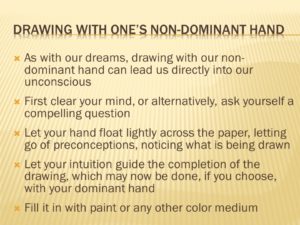
The Jungian-informed Technique of Drawing with the Non-dominant Hand
In much the same way that recurring symbols, the content of our dreams, and insights from synchronous events reveal meaningful content from the unconscious, drawing with our non-dominant hand opens our unconscious world to conscious reflection by intentionally journeying inward. Galen Martini (2014) provides the steps for drawing with our non-dominant hand:
- First clear your mind, or alternatively, ask yourself a compelling question
- With pencil in hand, let your hand float lightly across your paper, letting go of preconceptions
- Without interference from your conscious awareness, simply allow your hand to draw what it will, noticing what is being drawn
- Let your intuition guide the completion of the drawing, which may now be done, if you choose, with your dominant hand
- Fill the pencil drawing in with paint, or any other color medium that the drawing seems to call for
During the process of making the drawing, or upon reflection after its completion, your creation is likely to have a specific insight for you. This technique may be especially useful when facing some uncertainty about how best to proceed forward in your life. (Martini, personal communication, September 5, 2014)
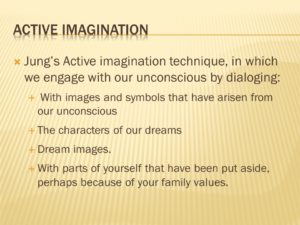
Active Imagination
Jung taught and used the technique, “Active Imagination,” in which we dialog with images from our unconscious, or with our dream characters. These could include parts of yourself that had been put away, perhaps because of your family’s values. In her second interview with this writer, Galen Martini (2014) stated:
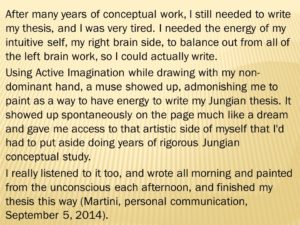
After many years of conceptual work, I still needed to write my thesis, and I was very tired. I needed the energy of my intuitive self, my right brain side, to balance out from all of the left brain work, so I could actually write. Using Active Imagination while drawing with my non-dominant hand, a muse showed up, admonishing me to paint as a way to have energy to write my Jungian thesis. It showed up spontaneously on the page much like a dream and gave me access to that artistic side of myself that I’d had to put aside doing years of rigorous Jungian conceptual study. I really listened to it too, and wrote all morning and painted from the unconscious each afternoon, and finished my thesis this way. (Martini, personal communication, September 5, 2014)
Adler’s & Jung’s Similar Insights
The Jungian Shadow has Consonance with Adlerian Feelings of Inferiority
Alfred Adler and Carl Jung were contemporaries, and for a time, both members of the Vienna Analytic Society (Hoffman, 1994). I found no evidence, however, that the concepts of inferiority, or the shadow aspects of being, were developed through collaboration, or any influence by one of these pioneering psychologists on the other. Both concepts appear to be independent constructs. Even so, our shadow and our inferiority do share some commonalities:
- Both our shadow, and inferiority, may reside to a large extent within the unconscious
- They are often hidden, unwanted and exiled from conscious awareness
- We often employ strategies to keep our shadow, and the inferior aspects of ourselves, hidden from others
- Owning our shadow, and our inferiority, and publicly acknowledging their presence in our makeup, frees up the energy that is often used to hide their presence from others
- Integrating inferiority, and our shadow, ultimately makes us stronger, more whole and more human to ourselves and to others
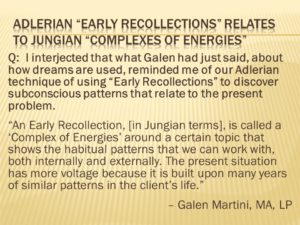
Adlerian “Early Recollections” relates to Jungian “Complexes of Energies”
During one of my interviews with Galen Martini (2014), she had just expounded on a Jungian way to work with dreams. I interjected that her explanation reminded me of Alfred Adler’s technique of using “Early Recollections” to discover unconscious, or at least less conscious, patterns that relate to a presenting problem. Ms. Martini answered:
An Early Recollection, [in Jungian terms], is called a ‘Complex of Energies’ around a certain topic that shows the habitual patterns that we can work with, both internally and externally. The present situation has more voltage because it is built upon many years of similar patterns in the client’s life. (Martini, personal communication, September 5, 2014)
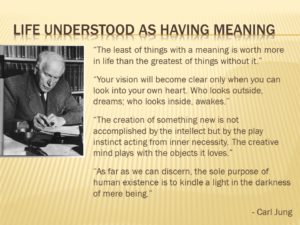
Life itself May Be Understood as Being Embedded with Meaning
Throughout Carl Jung’s writings, we find evidence of how important “life-meaning” was to him. The following quotations illustrate this: “The least of things with a meaning is worth more in life than the greatest of things without it” (Jung, 2015). “Your vision will become clear only when you can look into your own heart” (Jung, 2015). “Who looks outside, dreams; who looks inside, awakes” (Jung, 2015). “The creation of something new is not accomplished by the intellect but by the play instinct acting from inner necessity. The creative mind plays with the objects it loves” (Jung, 2015). “As far as we can discern, the sole purpose of human existence is to kindle a light in the darkness of mere being” (Jung, 2015).
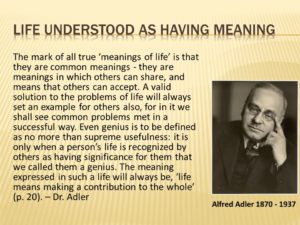
In Alfred Adler’s writings we also have a great many references to life-meaning. Here is one quotation that powerfully illustrates this:
The mark of all true ‘meanings of life’ is that they are common meanings – they are meanings in which others can share, and means that others can accept. A valid solution to the problems of life will always set an example for others also, for in it we shall see common problems met in a successful way. Even genius is to be defined as no more than supreme usefulness: it is only when a person’s life is recognized by others as having significance for them that we called them a genius. The meaning expressed in such a life will always be, ‘life means making a contribution to the whole’. (Adler, 1992, p. 20)
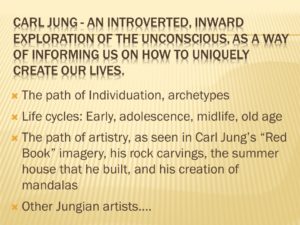
Jung’s Introverted Orientation Contrasts with Adler’s Extroverted Orientation
In general, Carl Jung preferred a more introverted, inward exploration of the unconscious, as a way of informing us on how to uniquely create our lives. We see evidence of this in many of his concepts including:
- The path of “Individuation”
- Jung’s exploration and extensive writings about archetypes
- Life cycles, including our infancy and early years, adolescence, midlife and old age
- The path of artistry, as seen in Carl Jung’s drawings, paintings, calligraphy, mandalas, rock carvings and the summer house that he designed and built
- The artistic creations of Jungian artists
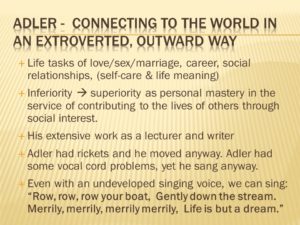
In contrast to the inwardly focused approach of Carl Jung, Alfred Adler seemed to primarily connect to the world of others in an extroverted, outward way. His following concepts illustrate this:
- The life tasks of love, sex and marriage, work and career, and social relationships are about connecting to others
- The movement from inferiority to superiority, as personal mastery in the service of contributing to the lives of others
- Social interest and community feeling
- His extensive work as a lecturer
- Alfred Adler’s writings were predominantly assembled from his lectures rather than the more introverted approach of directly writing
- Adler sang for others, even performing in public places
- He had rickets yet chose to move his body extensively, in spite of the disease, which is an active, outward strategy rather than an inner, more meditative one
Author Edward Hoffman quoted Alfred Adler who described the difficulties he had as a young boy with rickets: “… for me movement of any sort was a strain…” Hoffman goes on to describe how the young Adler responded: “In the wide meadows that stretched behind the house, Alfred joined his many friends in vigorous games, and his rickets eventually dissipated” (E. Hoffman, p. 7).
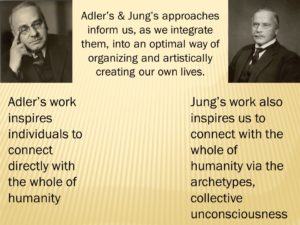
Integrating Adler’s and Jung’s Insights for Artistically Creating Your Life
Adler’s & Jung’s approaches inform us as we integrate them into an optimal way of organizing and artistically creating our own lives.

Connecting with the Whole of Humanity
Both Alfred Adler and Carl Jung emphasized the universality of our humanity and how we may connect more fully with our fellow humans. Dr. Adler inspires us to connect directly with the whole of humanity, through our work, our intimate relationships, all of our other social connections and even more universally by embracing social interest and community feeling as a way to be in the world.
Dr. Jung also inspired us to connect with the whole of humanity via archetypes, the collective unconscious, the universality of symbols and by understanding and honoring cultures that might be quite different from our own. He did so in his own life through his connection with far Eastern, African and American Indian cultures employing travel, study and translation of their worldviews to expand the understanding of westerners in ways that deepened, corroborated and expanded our Western civilization’s psychological and philosophical models.
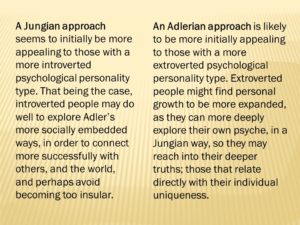
Adler and Jung Developed Methods for Mining Our Unconscious for Insights
Carl Jung showed us ways to bring our unconscious shadow side into conscious awareness. By exploring our unconscious through dream-work, symbols, synchronous events and artistic pursuits, (including drawing with our non-dominant hand), we learn to pay attention to those dormant, unacknowledged or fragmented aspects of ourselves. Doing so helps us to become more whole by consciously deciding how we may incorporate those less conscious parts into the whole of our being.
Our inattention and ignorance of our shadow self, on the other hand, provides no protection against our shadow’s influence upon us; Eugene Beniek (2014) stated: “Our shadow will instead operate as a shadow government that at times hijack’s our lives” (Beniek, personal correspondence, August 2014).
Alfred Adler’s method for assessing peoples’ deeper and more fundamental life goals, known as the “Style of Life,” provides a way to bring those less-than-conscious ways of being into greater conscious awareness. Through detailed questioning about upbringing we may learn of:
- Interactions and held beliefs by peoples’ mother, father, siblings and other significant family members
- Psychological birth order, including the overall attitudes and beliefs that were individually embraced significance within the family
- The gender roles that were modeled
- Families’ held beliefs about the world itself
All of these contribute to the overall way people choose to move through their lives. Absent a method like the style of life, peoples’ most fundamental life goals, their ways of moving through life and relating with others, might remain largely unconscious. Much like the shadow self, our style of life powerfully influences us. By bringing our style of life into conscious awareness, we are in a stronger position to choose how our past influences may inform the life we wish to live rather than dictate it.
Alfred Adler also had a way of working with dreams. Yet his most commonly utilized method for directly accessing our unconscious is the technique of asking for, recording and interpreting “Early Recollections” (ER’s). Like Jung, Alfred Adler’s dream techniques, style of life analysis and ER technique take us directly into our unconscious, so we might make the unknown in ourselves known.
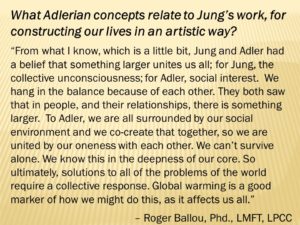
This question was asked to Dr. Roger Ballou: “What Adlerian concepts relate to Jung’s work, for constructing our lives in an artistic way?” Dr. Ballou answered:
From what I know, which is a little bit, Jung and Adler had a belief that something larger unites us all; for Jung, the collective unconsciousness; for Adler, social interest. We hang in the balance because of each other. They both saw that in people, and their relationships, there is something larger.
To Adler, we are all surrounded by our social environment and we co-create that together, so we are united by our oneness with each other. We can’t survive alone. We know this in the deepness of our core. So ultimately, solutions to all of the problems of the world require a collective response. Global warming is a good marker of how we might do this, as it affects us all. (Ballou, personal communication, September 9, 2014)
Our Psychological Personality Type Informs How We Might Artistically Proceed
An inner-directed Jungian approach might initially be more appealing to those with introverted psychological personality types. That being the case, introverted people may do well to explore Adler’s more socially embedded ways, in order to connect more broadly with others and reduce their risk of becoming insular. An Adlerian approach might initially be more appealing to those with greater extroversion in their psychological personality type. Extroverted people might find a greater depth of personal growth, however, as they can deeply explore their own psyche in a Jungian way by journeying deeply into their individual uniqueness.
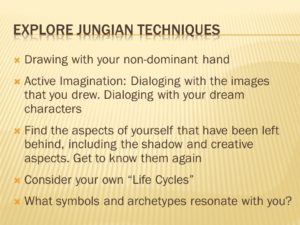
Explore Jungian Concepts and Jungian-Informed Artistic Techniques
Jungian concepts and Jungian-informed techniques are designed to uncover the deeper truths contained within our personal unconscious, and our collective unconscious, so that we might work with those truths productively, once we become consciously aware of them. Many of the following techniques were gleaned primarily from artist, writer and Jungian analyst, Galen Martini:
- Write from the unconscious by clearing our minds, relaxing our bodies and journal, without consciously directing the writing (Martini, personal communication, September 5, 2014)
- Assemble “Found Poems” by walking through a library or bookstore and jotting down the titles or parts of titles that seem to stand out for us (Martini, personal communication, September 5, 2014)
- Draw with your non-dominant hand (Martini, personal communication, September 5, 2014)
- Engage in “Active Imagination” through dialoging with the images that we have drawn (Martini, personal communication, September 5, 2014)
- Engage in “Active Imagination” through dialoging with the characters of our dreams (Martini, 2011)
- Find and get to know those aspects of ourselves that have been left behind, including our shadow parts, as well as the creative aspects of our psyches (Martini, personal communication, September 5, 2014)
- Reflect upon our “Life Cycles”
- Identify and explore those symbols and archetypes that resonate with us
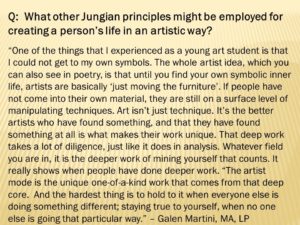
We might also benefit by entering into Jungian analysis with a qualified Jungian analyst so we can specifically explore our psyche in a more complete and in-depth way. In one of my interviews with Galen Martini, I posed this question: “What other Jungian principles might be employed for creating a person’s life in an artistic way?” She responded:
One of the things that I experienced as a young art student is that I could not get to my own symbols. The whole artist idea, which you can also see in poetry, is that until you find your own symbolic inner life, artists are basically ‘just moving the furniture’.
If people have not come into their own material, they are still on a surface level of manipulating techniques. Art isn’t just technique. It’s the better artists who have found something, and that they have found something at all is what makes their work unique. That deep work takes a lot of diligence, just like it does in analysis. Whatever field you are in, it is the deeper work of mining yourself that counts. It really shows when people have done deeper work.
The artist mode is the unique one-of-a-kind work that comes from that deep core. And the hardest thing is to hold to it when everyone else is doing something different; staying true to yourself, when no one else is going that particular way. (Martini, personal communication, September 5, 2014)
Explore Adlerian Techniques and Concepts
Alfred Adler’s writings that speak of movement powerfully inform how we might artistically create our lives. As we reflect upon where we have been, what we have done, and how our experiences have impacted us, we gain confidence for making decisions on our future direction, including those immediate actions that help us create new projects, connect with others in more significant ways and propel our lives forward.
For this writer, the path that leads to fruition is our quest for mastery by moving from inferiority to superiority. We intentionally move our lives forward on the horizontal axis of contributing to the welfare of others. In addition to movement, useful Adlerian methods for artistically creating our lives include:
- Exploring our early recollections to gain present-time insights from our unconscious
- Reflecting upon and strategically managing our life tasks, so we might more fully engage with others, thereby living with greater life balance
- Embracing our inferiorities as an integral aspect of our humanness, so that we may free up the energy presently used to hide the parts of ourselves that we have deemed to be inferior.
- Moving horizontally towards community feeling by learning from, receiving from and giving to each other to deepen our bonds with those that we know and with all of humanity
Alfred Adler’s optimistic and courageous response to vocal cord problems provides a model for how to best respond to life’s challenges in a creative and energized way. The inferiority of his voice did not deter him. Employing the same strategy of use and movement that he used to cure his rickets, Adler sang anyway, eventually developing both his singing voice and the strong lecturing voice.
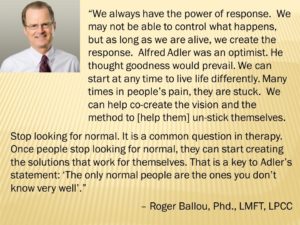
Adler Graduate School of Minnesota Professor Herb Laube shared the story of visiting the historic Central Café in Vienna, along with Professor Marina Bluvshtein, where amateur musician Alfred Adler enjoyed singing music in both classical and popular idioms. (Laube, personal communication, June 6, 2014) For this writer, singing in both classical and popular styles exemplifies an egalitarian approach to music consistent with a high degree of social interest. In my interview with Roger Ballou (2014), he eloquently shared Adler’s way, saying:
We always have the power of response. We may not be able to control what happens, but as long as we are alive, we create the response. Alfred Adler was an optimist. He thought goodness would prevail. We can start at any time to live life differently. Many times in people’s pain, they are stuck. We can help co-create the vision and the method to [help them] un-stick themselves.
Stop looking for normal. It is a common question in therapy. Once people stop looking for normal, they can start creating the solutions that work for them. That is a key to Adler’s statement: “The only normal people are the ones you don’t know very well. (Ballou, personal communication, September 9, 2014)
Generalized Protocol Summaries for Artistically Creating Our Lives
Utilize Adler’s Principle of Teleological Movement
Alfred Adler postulated that much of our behavior can be ascribed to teleological movement towards our goals. But absent an introspective process, or a therapeutic process, which might include a style of life analysis for those involved with Adlerian psychotherapy, the goals themselves, and our movement towards those goals, often remain below conscious awareness. Intentionally employing teleological movement towards consciously formulated goals may be enhanced by:
- Directing our movement inward into the rich landscape of our unconscious, or even deeper, into our collective unconscious, to illuminate new insights and expand our existing understanding
- After having an insight or inner discovery, retrieve it by moving outward from our unconscious back into our more usual conscious state, manifesting what we have discovered by translating it into form, via a medium of our choosing
Choose Mediums of Expression that are Personally Optimal for Artistically Creating
- Alfred Adler’s primary medium of public lecturing, which may include storytelling, constitutes a powerful and expressive performance art that may profoundly captivate and influence watchers and listeners via sight, the depth and expression of hearing the speaker’s voice and the palpable group energy kinesthetically felt by most all who are present
- Writing as fiction – which is a very sophisticated form of storytelling that typically incorporates the deeper and more poignant experiences that we have as humans – tends to connect writers and readers to the universality of our human experience
- Nonfiction writing as a medium, (as both Carl Jung and Alfred Adler engaged in throughout their professional lives), has an advantage over public lecturing in communicating a greater breadth and depth of understanding, and offering the opportunity to reread a work, than is possible with public lectures
- Movement arts, including dance, mime, acting and athletics, use our bodies themselves as a vehicle for communicating stories and human experiences within space, via rhythmic movement through time
- The healing arts, including psychotherapy, make use of highly integrated sets of skills requiring a depth of knowledge, critical thinking and compassionate human connection with others for the purpose of relieving suffering and promoting wellness
- Music composition – the creative manipulation of intervals and rhythm – allows composers to create a consistent world of sound, as each aspect of the composition aesthetically and synergistically relates to all of the other aspects of the work
- Music performance, (engaged in by Alfred Adler through singing), compels musicians to honor the recipes that composers have created by freshly creating those compositions as unique, creative acts, which have a one-time existences within fixed segments of time, never to be created again in exactly the same way
- The visual arts, including but not limited to drawing, painting, sculpture, pottery, weaving, glassblowing, architecture, artisan work and graphic design, exist within the world of space and may last from the time of their creation until their destruction.
- Science, technology, invention, entrepreneurial business, teaching and the full expression of human endeavors may be done creatively
- The ultimate medium for everyone is our own lives, and how invent, reinvent and live them
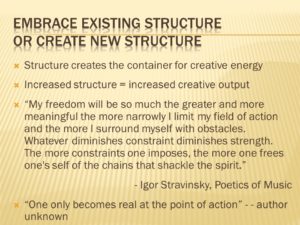
Embrace Existing Structure or Create New Structure
Structure creates the container for creative energy. Absent structure, creative people often experience the frustration of failing to produce actual creations. People commonly have the mistaken notion that limits, boundaries, and structure itself is the antithesis of being creative. But this is not so. Increased structure actually increases our creative output.
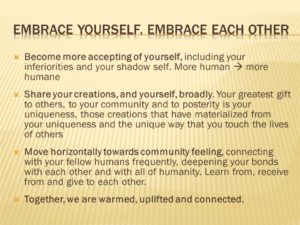
Become More Accepting of Yourself, and of Others
Artistically creating our lives can blossom through acceptance of our inferiorities and of our shadow self. Alternatively, having a perfectionistic stance typically leads to self-doubt and procrastination. Perfectionism is not the same as high standards; it instead consists of impossibly unrealistic standards, leading to despair. As we embrace our humanness, we become more humane. Accepting ourselves and embracing ourselves, as well as accepting and embracing our fellow humans, is integral to artistically creating the life that we want.
Share Your Creations, and Yourselves, Broadly
Our greatest gift to others, to our community, and to posterity, is our uniqueness. Sharing those creations that have materialized from our uniqueness, and the unique ways that we have touched the lives of others, serves to warm, uplift and connect us with our fellow humans and the whole of humanity.
Take Action
The one indispensable ingredient for artistically creating our lives is action. To truly benefit, we must do more than simply consider Adler’s and Jung’s insights for artistically creating our lives; we must act. This quotation, whose author is unknown to this writer, poignantly implores us to act: “One only becomes real at the point of action.”
Summary Ideas of Alfred Adler and Carl Jung
For Carl Jung, the process of growth was primarily focused on journeying directionally inward, to deeper and deeper levels of the psyche, in exploration of our unconscious. In so doing, we are likely to perceive a great deal of our own reservoir of imagery, myth and psychic building-block materials from which we eventually construct a more artistically oriented life.
With an exclusive Jungian approach to artistically creating our lives, devoid of an Adlerian call to contribute and serve the whole of humankind, increased personal understanding may not necessarily make use of our increased inner psychological insights in ways that are practical and useful to our fellow humans.
For Adler, we also connect to our deeper and more inner aspects of our psyche, through the use of early recollections and exploration of our style of life. After connecting with our less conscious mental constructs, we may intentionally choose to analyze them through the lens of common sense and social interest, rather than through a private sense lens of viewing ourselves, our relationships and our place in the community.
This Adlerian approach places us in service to social interest as we artistically reinvent ourselves, fulfilling our life tasks and connecting us to the larger community of humans.
References
Adler, A. (1917). Study of organ inferiority and its psychical compensation. New York, NY: The
Nervous and Mental Disease Publishing Company.
Adler, A. (1931). What life could mean to you. Rockport, MA: Oneworld Publications.
Ansbacher, H. L., & Ansbacher, R. R. (1956). The individual psychology of Alfred Adler: A systematic presentation in selections from his writings. New York, NY: Basic Books
Inc.
Bottome, P. (1957) Alfred Adler: A portrait from life. New York, NY: The Vanguard Press
Chandler, R. J. (2013). Midlife reinvention to pre-death metamorphosis: Carl Jung’s travel-
guide to the second half of life. Richfield, MN: Adler Graduate School.
Franken, A. S. (1991). Daily affirmations with Stuart Smalley. New York, NY: SNL.
Hoffman, E. (1994). The drive for self: Alfred Adler and the founding of individual psychology.
Reading, MA: Addison-Wesley Publishing Company.
Jung, C. G. (1971). Psychological types. Princeton, NJ: Princeton University press.
Jung, C. G. (1964). Man and his symbols. London, England: Aldus Books Limited.
Jung, C. G. (1964). Online quotations retrieved from
Jung, C. G. (2009). Introduction. In Shamadasani, S. (Ed.), The red book: Liber novus. (pp. 193-
221). New York, NY: WW Norton & Company.
Martini, G. (2006). Finding your own life: The path to individuation. Saint Cloud, MN:
IntegraLife Publishing.
Martini, G. (2011). Dream manual for therapists and other listeners. Saint Cloud, MN: North
Star Press of Saint Cloud, Inc.
Millner, N. B. (2004) Applied Jungian psychology: Navigating the seasons of later life: A self-
exploration guidebook for MBTI users. Greenville, SC: CAPT.
Mosak, H. H., Pietro, R. D. (2006). Early recollections: Interpretive method and application.
New York, NY: Routledge, Taylor & Francis Group.
Myers, K. D., Myer, P. B. (2001, 2003). Myers-Briggs Type Indicator® Step II ™ (Form Q)
Interpretive Report. Sunnyvale, CA: CPP, Inc.
Oberst, U.E., Stewart, A.E. (2003). Adlerian psychotherapy: An advanced approach to
individual psychology. New York, NY: Brunner-Routledge.
Acknowledgements
I gratefully wish to thank, acknowledge and express my deep appreciation to my professors, our administration, staff, (with special thanks to Earl J. Heinrich), and fellow students of the Adler Graduate School
Galen Martini, MA, LP, Jungian Analyst and artist for your generous contribution of time, knowledge and original art. Your interviews opened the Jungian the world of artistry for me.
Roger Ballou, PhD, LMFT, LPCC for your interview and ongoing support, both for this project and through your supervision classes. I treasure your profound expression of Adlerian thought.
Marina Bluvshtein, PhD, LP, LMFT, my Master’s Project Chair, and Ev Haas, MA, my MP Reader, for your encouragement, for attending my November 8th, 2014 community presentation in Saint Cloud, MN, and for your insight and guidance throughout this Master’s Project.
Herb Laube, PhD, LMFT, for your contribution to my Master’s Project, your supervision mentorship and for your gift of connecting through stories.
Eugene Beniek, MA, LICSW, LMFT, for mentoring me through your role as my clinical supervisor. Your curiosity and compassion for clients continues to enthuse and inspire me.
Bonnett Chandler, my romantic mate, wife and practice partner. Taking this academic journey with you, hand-in-hand, has been delightful, satisfying, supportive, and in every way fantastic!
Table of Contents
Abstract ……………………………………………………………………………………….. 2
Acknowledgements …………………………………………………………………………… 3
Table of Contents ……………………………………………………………………………… 4
What Motivated this Choice of Topic?………………………………………………………… 5
Why Alfred Adler’s and Carl Jung’s Insights Inform Artistic Creation of Our Lives? ………. 5
Alfred Adler’s Insights for Artistically Creating Our Lives ………………………………….. 6
Carl Jung’s Concepts Inform Artistic Creation ………………………………………………. 12
Adler’s & Jung’s Similar Insights …………………………………………………………… 19
Jung’s Introverted Orientation Contrasts with Adler’s Extroverted Orientation …………… 21
Integrating Adler’s and Jung’s Insights for Artistically Creating Your Life ………………… 22
Generalized Protocol Summaries for Artistically Creating Our Lives ……………………….. 29
Summary Ideas of Alfred Adler and Carl Jung ………………………………………………. 32
References ……………………………………………………………………………………. 33
